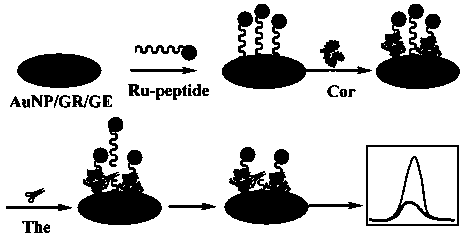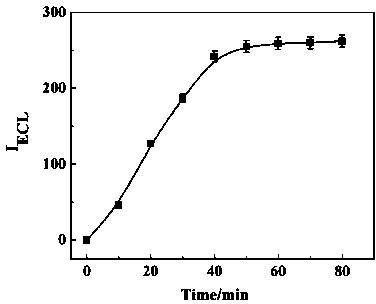Method for determining cortex actin by electrochemical luminescence
An actin and electrochemical technology, which is applied in the field of analytical chemistry and electrochemiluminescence detection, can solve the problems of complex operation and expensive equipment, and achieve the effect of low material cost, low cost and high sensitivity
- Summary
- Abstract
- Description
- Claims
- Application Information
AI Technical Summary
Problems solved by technology
Method used
Image
Examples
preparation example Construction
[0032] The preparation of electrochemiluminescent probe is characterized in that it comprises the following steps:
[0033] Preferably, 2.0 mg of the peptide is dissolved in 10 ml of absolute ethanol, and then 5 mg of Ru-NHS (Ru(bpy) 2 (dcbpy)NHS) solution, stirred and incubated overnight at 4°C to obtain an electrochemiluminescent probe (Ru-peptide).
[0034] The preparation of electrochemiluminescent probe sensor is characterized in that it comprises the following steps:
[0035] Preferably, gold nanoparticles and graphene-modified electrodes are soaked in 50 μL of electrochemiluminescence probe solution (phosphate buffer solution pH 7.4 + 5 mM TCEP (trichloroethyl phosphate)), and incubated overnight at 4 °C with stirring, washing. Then soak in 100 μL 1.0×10 -3 M MCH reacted for half an hour, then washed the electrode three times with pH 7.4 phosphate buffer solution, dried the surface of the electrode, and obtained. Store at 4 °C for later use.
[0036] Electroch...
Embodiment
[0043] Example: A method for measuring cortical actin by electrochemiluminescence
[0044] 1. Experimental part
[0045] 1.1 Instruments and reagents
[0046] Carboxylated ruthenium pyridine (Ru(bpy) 2 (dcbpy)NHS: bis(2,2'-bipyridine) (2,2'-pyridine-4,4'-dicarbonate) ruthenium succinamide, Ru-NHS), N,N'-dicyclohexylcarbodi Imine (EDC), thermolysin, TPA (Sigma, USA); cortical actin (Wuhan Huamei Bioengineering Co., Ltd.); N-hydroxysuccinimide (NHS, Shanghai Yanchang Biochemical Company); chloroauric acid (HAuCl 4 , Shanghai Reagent No. 1 Factory, China); trichloroethyl phosphate (TCEP), mercaptohexanol (MCH) (Aladdin Reagent Co., Ltd.).
[0047] The sequences of the peptides used (purity >95%, Bio-Thera Biotechnology) are as follows:
[0048] 11-mercaptodecanoic acid-GLSKKRPPPPPPGHKRT.
[0049] CHI660B electrochemical workstation (Shanghai Chenhua Instrument Office); MPI-E electrochemiluminescence analysis system (Xi'an Ruimai Analytical Instrument Co., Ltd.); three-e...
PUM
 Login to View More
Login to View More Abstract
Description
Claims
Application Information
 Login to View More
Login to View More - R&D
- Intellectual Property
- Life Sciences
- Materials
- Tech Scout
- Unparalleled Data Quality
- Higher Quality Content
- 60% Fewer Hallucinations
Browse by: Latest US Patents, China's latest patents, Technical Efficacy Thesaurus, Application Domain, Technology Topic, Popular Technical Reports.
© 2025 PatSnap. All rights reserved.Legal|Privacy policy|Modern Slavery Act Transparency Statement|Sitemap|About US| Contact US: help@patsnap.com



